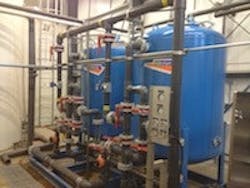Decontaminating the Ross River Water Treatment Plant
In April 2008, AdEdge Water Technologies LLC was contacted by the Yukon government to provide an arsenic, iron and manganese removal system for the Ross River Water Treatment Plant in Yukon, Canada. The water system serves a community of 350 residents. The existing water system consisted of a well feeding into a distribution system with a maximum capacity of 200 gal per minute. AdEdge ran a small-scale pilot of the project for five months in the summer and fall of 2008. After successful piloting of the treatment approach, AdEdge was awarded the project.
The raw water has an arsenic level of 14 ppb, above the Canadian Health Maximum Acceptable Concentration (MAC) of 10 ppb. The raw water also has a fluctuating manganese level between 0.072 mg/L and 0.093 mg/L and an iron level 0.26 mg/L, above the Canadian Aesthetic Objective (AO) of 0.05 mg/L and 0.3 mg/L, respectively.
Treatment Solution
The AdEdge treatment approach features a skid-mounted AD26 oxidation/filtration system for iron and manganese removal and a skid-mounted granular ferric oxide (GFO) adsorption system for arsenic removal. Water is pumped from the well and treated with a continuous feed of sodium hypochlorite via the AdEdge ADIN chemical feed system to optimize the removal of arsenic and to oxidize the AD26 media.
The water then processes through the AD26 arsenic and manganese removal system consisting of three 36-in. diameter vessels. Each vessel contains 22 cu ft of the AD26 manganese dioxide media. Following the AD26 treatment system, the water is treated by the skid-mounted GFO arsenic removal system consisting of two 54-in. diameter vessels. Each vessel contains 50 cu ft of the AdEdge GFO adsorption media. The water is injected with sodium hypochlorite to disinfect in prior to feeding a 2,000 gal atmospheric storage tank before distribution.
The system was supplied with automatic controls, pressure gauges and sample ports for a complete treatment package. An AdEdge InGenius PLC serves as the central control center for the treatment system. The operator interacts with the system through a color touch-screen HMI interface for monitoring and control of system parameters. The system also features the InVue Remoting Monitoring System allowing operators to access the system through the HMI from an offsite location via the Internet or a cellular data connection. Backwashing of the treatment vessels prevents poor water quality and pressure loss and is initiated by the automatic controls on each vessel. AdEdge provided an H2Zero Recycle/Backwash system reclaims 100% of the backwash wastewater and removes the captured arsenic, iron and manganese as a semi-solid sludge that can be disposed of in a non-hazardous landfill. Backwashing for the GFO vessels occurs once every 60 days and once a week for the AD26 vessels.
Meeting Treatment Goals
Startup of the treatment system occurred in August 2012. Since the system went online, arsenic, iron and manganese levels have lowered to below the Canadian standards of 10 ppb. 0.3 mg/L and 0.05 mg/L, respectively.
